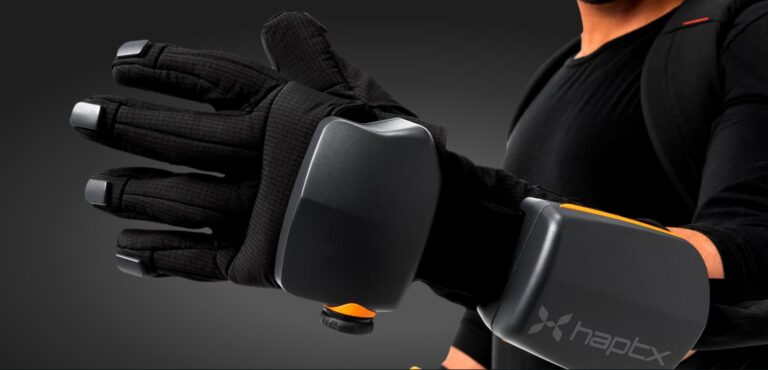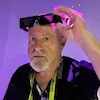
Augmented World Expo (AWE) had its 15th annual conference and exhibition in Long Beach, CA, last week (June 18-20). The conference featured over 500 speakers over three days, and the expo hall had over 300 exhibitors. Part I of this series focused on the keynotes, panels, and major announcements, which focused on mobile AR and Mixed Reality. AI, despite my predictions, took a backseat. In this second installment, I’m going to talk about what I saw on the ground in the exhibit hall. There, we saw an AWE where enterprise, entrepreneurs, games and entertainment meet.
AWE’s Walk of Fame honored the first 101 pioneers inducted into the new Hall of Fame. There were a slew of announcements by players not named Meta, Snap, Qualcomm, and Niantic as the show opened. They can be found here. The biggest tech companies have their own developer conferences, so their presence on the expo floor is limited (but always popular).
Indeed, experiences in the Meta Quest app store seem to have delivered the most success to indie developers like Distance Technologies, established by the co-founders of enterprise headset maker Varjo. It showed off its prototype using an LCD panel pointed up at a windshield with a reflective coating, projecting a transparent image onto it similar to heads-up displays in Audis and Volvos.
Those simple systems use a microprojector on the dash and the windshield as the reflective screen, thus creating a composite view. Distance Technology uses an eye-tracking system to show a fully 3D map, which can be toggled to show different views. Urho Konttori, CEO and co-founder of Distance Technologies told me their target market is automotive and aerospace.
Johnny Monsarrat gave me a spontaneous demo of his remarkable outdoor roleplaying video game (Outdoor RPG) for mobile AR. It’s free in the app stores now. Unlike scavenger hunt games where you walk to GPS points and stop, Monsarrat lays out a game landscape across any real world outdoor space, which you walk through to explore. “This way,” says Monsarrat, “any park can be a theme park.” On your phone’s camera mingled with physical reality you see hundreds of fantasy trees, rocks, creatures, buildings and other game content, forming a roleplaying game world.
At the entrance to the exhibit hall the first thing I saw were Spacetop, Meta, Tap, and Qualcomm. Spacetop is a laptop without a monitor. Instead, it uses Nreal’s new XR glasses to provide what appears to be a big screen monitor.
Tap is a wristband that replaces your keyboard, mouse & handheld controller. Users tap on a tabletop or the air. TapXR now supports advanced multi-finger gestures, delivering a more fluid, immersive, and intuitive way to navigate, scroll, select, drag, drop, and activate content in both spatial and standard computing environments – without sacrificing precision or comfort.
Qualcomm’s booth was filled with its partners and members of its developer relations team for Snapdragon Spaces, which allows developers’ software to operate across all the devices using their Snapdragon chipset.
Most of what you see on the floor is for enterprises, not consumers. Either companies selling tech to the XR industry, or XR companies providing hardware and software for training and simulation. There are vendors of optics (Digilens), sensors of all kinds (Ultraleap), accessories (FreeaimVR), Games tools for creating, managing, editing, and storing 3D content (ShapesXR, Playbook AI), and collaboration tools like Campfire 3D and Cisco WebEx.
HaptX announced it has begun shipping its new G1 haptic gloves. The company says they have tens of millions of dollars in preorders to fill. The G1 has improved ergonomics and fit, multiple sizes, expanded haptics, and multi-user collaboration features.
This year’s Playground featured a record 17 booths filled with interactive stories, innovative XR fundraising campaigns, multiplayer games, AR unicorn rides, a giant arcade cabinet, and an inflatable astronaut hovering over the entire playground. You can view all the Playground experiences here.
Big Rock Creative had an eye-catching speeder in its booth. They were sharing BurnerSphere, an immersive app that lets users experience Black Rock City in VR with 3D models and 360/180 videos from Burning Man. They opened up their alpha version applications at the start of AWE, June 18.
Spacebar is a VR arcade set in the wild west of cyberspace. Their 15’ tall arcade cabinet invites players on the outside to use physical pinball controls, while others go inside the machine, for a head-to-head contest of pinball meets dodgeball. Live VR games are fun, period. We played knock hockey and darts, but there were many more.
A giant inflatable astronaut drew me to Lunar Light by Back to Space. Donning a backpack, you journey to the moonbase on a monorail taking in the sights of the lunar surface. I’m told they’ll be bringing their attraction to Santa Monica, CA later this year.
Brent Bushnell, former Chairman of Steam Carnival and Two Bit Circus, has created Creator Campus: “a downloadable theme” you can put in a park, parking lot, ball field, or anywhere. It offers a number of mixed reality games, including a shooter and a racing game, Rydeables, in which users in VR headsets raced themed electric wheelchairs through gates only they could see. It was too much fun and I had too little time. This feels like a great idea to me.
The three things people said I have to try were Pillow (Lucas Rizzotto is a great artist working on XR), Fanport (Dave Lorenzini told me), and the VR dancing app, Let’s Dance, from Dark Arts (Sarah Hill told me). We’ve reviewed Pillow in the past but they’ve added features like Sky Fishing, just for AWE. If Meta is looking for Mixed Reality lifestyle applications, they were in abundance in AWE’s playground this year. They can’t miss Let’s Dance. My virtual dance partner said I was great, and loved her wardrobe changes.
Fanport, developed by Draw & Code and 302 Interactive, is social, interactive, and designed to do things that a VR arcade or other established location-based systems cannot – solve the throughput problem. In the demo, three of us wore Magic Leap 2 HMDs to fight invaders which literally came out of the wall, much like the original ML 1 game “Dr. Grordbort’s Invaders.” Supposedly the system can handle over a hundred simultaneous users, which would be a breakthrough.
Getting that many people into headsets at once – and cleaning them – is the new logistical problem. Kagami, an experimental performance with a hundred people in Magic Leap 2 headsets, ran for a month last summer at New York’s Shed Theater off-Broadway.
Neon Arches led attendees from the expo floor into the XR Museum, which featured over 80 vintage XR devices donated by pioneers. Highlights include the 1990 Xybernaut (one of the first wearable computers), The Disney Aladdin Headset, The Nintendo Virtual Boy, and the original Meta AR headset, which was made years before Facebook acquired their name.
Special immersive experiences presented by The Immersive Archive Project USC Mobile & Environmental Media Lab will allow attendees to explore Ivan Sutherland’s first ever Head Mounted Display from 1968, and Morton Heilig’s Sensorama from 1961 – the first multisensory immersive cinema experience pre-dating VR, which is being restored by a team under Scott Fisher at USC.
Additionally, the XR Museum pays tribute to the first 101 XR pioneers who were inducted into the XR Hall of Fame in 2024 with a photo gallery and their claim to fame. Their “stars” adorned the museum’s wall and also were on the carpet at the Convention Center entrance.
Finally, the Auggie Awards took place on Wednesday evening, June 19th, right before the induction ceremony for the first 101 members of the AWE Hall of Fame. You can see all the winners below and on the AWE Blog. Congrats to all the winners.
- Best Art or Film: JFK Memento by TARGO: An Immersive Chronicle
- Best Campaign: New Messi Sandwich, CamIOn XR
- Best Climate Change Solution: SAMARitan by HENSOLDT Sensors
- Best Collaboration Tool: Webex Hologram by Cisco
- Best Consumer App: Pillow MR on Quest
- Best Content Creator(s): Between Realities VR Podcast
- Beat Creator and Authoring Tool: STYLY
- Best Developer Tool: 8th Wall/Niantic
- Best Education & Training Solution – ImmerseLearn by Korea Electric Power Corporation (KEPCO)
- Best Enterprise Solution: Campfire
- Best Game or Toy: Kluest by Sons of a Bit Entertainment
- Best Headworn Device: Meta Quest 3
- Best Health & Wellness: American Heart Association’s Hands-Only CPR
- Best Indie Creator: 3lb Games
- Best Interaction Product: HTC Vive Ultimate Tracker
- Best startup: Playbook XR, which also won the startup pitch competition, was judged by investors Marco DeMiroz (The Venture Reality Fund), Adam Draper (Boost VC), and Abigail Albright (WXR Fund).
- Best Location-Based Entertainment: Japantown Geospatial for Paper Tree Origami by Rock Paper Reality
- Best Societal Impact: TouchKEY+ Multisensory Station by WEART
- Best Use of AI: AI and Augmented Reality at Pfizer
- Best Web3 Implementation: SEPHORA UNIVERSE by SURREAL Events
 Charlie Fink is the author of the AR-enabled books “Metaverse,” (2017) and “Convergence” (2019). In the early 90s, Fink was EVP & COO of VR pioneer Virtual World Entertainment. He teaches at Chapman University in Orange, CA. Follow him on Twitter or LinkedIn, and check out his website or other work.
Charlie Fink is the author of the AR-enabled books “Metaverse,” (2017) and “Convergence” (2019). In the early 90s, Fink was EVP & COO of VR pioneer Virtual World Entertainment. He teaches at Chapman University in Orange, CA. Follow him on Twitter or LinkedIn, and check out his website or other work.

